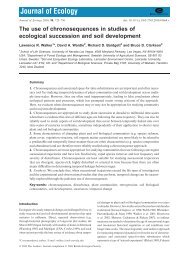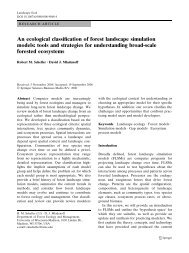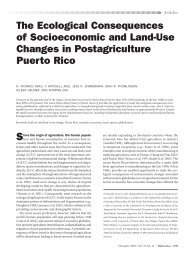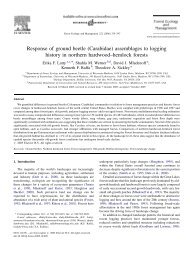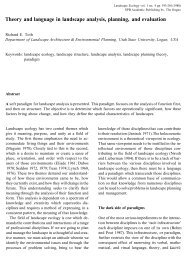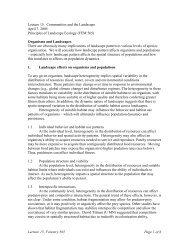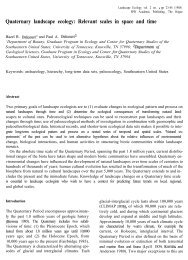Improving the formulation of tree growth and succession in a ...
Improving the formulation of tree growth and succession in a ...
Improving the formulation of tree growth and succession in a ...
You also want an ePaper? Increase the reach of your titles
YUMPU automatically turns print PDFs into web optimized ePapers that Google loves.
S. Schumacher et al. / Ecological Modell<strong>in</strong>g 180 (2004) 175–194 179<br />
accord<strong>in</strong>g to Eq. (1).<br />
B c = B i N c (1)<br />
The change <strong>of</strong> cohort biomass is tracked us<strong>in</strong>g a<br />
yearly time step <strong>in</strong> <strong>the</strong> model (cf. Fig. 1). Differentiation<br />
<strong>of</strong> Eq. (1) yields<br />
dB c<br />
= dB i<br />
dt dt N c + dN c<br />
B i (2)<br />
dt<br />
The first term represents changes <strong>in</strong> biomass <strong>of</strong> <strong>in</strong>dividual<br />
plants (<strong>growth</strong>), whereas <strong>the</strong> second term tracks<br />
changes <strong>in</strong> <strong>the</strong> number <strong>of</strong> <strong>in</strong>dividuals that form an age<br />
cohort (mortality).<br />
2.2.1.1. Tree <strong>growth</strong>. The <strong>growth</strong> model is based on<br />
<strong>the</strong> a priori assumption <strong>of</strong> a logistic <strong>growth</strong> relation<br />
(Eq. (3)) for <strong>the</strong> isolated plant (Eq. (3)). Note that <strong>in</strong> <strong>the</strong><br />
present context, this equation simply represents a phenomenological<br />
description <strong>of</strong> <strong>in</strong>dividual <strong>tree</strong> <strong>growth</strong>,<br />
not a model <strong>of</strong> population-level dynamics.<br />
dB i<br />
dt<br />
= r i (t)<br />
(<br />
1 − B i(t)<br />
K i (t)<br />
)<br />
B i (t) (3)<br />
The <strong>in</strong>dividual <strong>growth</strong> rate, r i (t), is derived from<br />
a species-specific maximum <strong>growth</strong> rate (r s ), which<br />
represents <strong>growth</strong> under optimum environmental conditions.<br />
The <strong>growth</strong> rate r i (t) is calculated as a function<br />
<strong>of</strong> three <strong>growth</strong>-limit<strong>in</strong>g factors, light availability<br />
(light rf), <strong>the</strong> sum <strong>of</strong> degree-days (DD rf) <strong>and</strong> a<br />
drought <strong>in</strong>dex (DrStr rf), as described below. We applied<br />
Liebig’s “Law <strong>of</strong> <strong>the</strong> M<strong>in</strong>imum” to comb<strong>in</strong>e <strong>the</strong>se<br />
<strong>growth</strong> response factors.<br />
r i (t) = r s m<strong>in</strong>(light rf (t),DD rf (t), DrStr rf (t))<br />
(4)<br />
Table 1<br />
General parameters used <strong>in</strong> <strong>the</strong> modified LANDIS model<br />
Name Parameter description Value<br />
k Light ext<strong>in</strong>ction coefficient 0.5<br />
B i (t = 0) (kg) Tree biomass at <strong>the</strong> time (t =0) 10<br />
<strong>of</strong> cohort establishment<br />
avL open<br />
Threshold light availability to 0.6<br />
def<strong>in</strong>e open canopy conditions a<br />
m rf<br />
Threshold <strong>growth</strong> reduction for 0.1<br />
stress-related mortality<br />
m<strong>in</strong>Yrs M<strong>in</strong>imum <strong>of</strong> stress years 3<br />
a A relative light availability <strong>of</strong> 60% corresponds to a canopy<br />
closure <strong>of</strong> 15% (Kimm<strong>in</strong>s, 1987), which we def<strong>in</strong>ed as non-forest.<br />
Also, maximum plant size, K i (t), is implemented<br />
as a function <strong>of</strong> environmental conditions (Eq. (5)).<br />
It is reduced by degree-days (DD rf) <strong>and</strong> drought<br />
(DrStr rf), start<strong>in</strong>g from a species-specific maximum<br />
plant size under optimal environmental conditions<br />
(K s ).<br />
K i (t) = K s m<strong>in</strong>(DD rf (t), DrStr rf (t)) (5)<br />
The light response function (light rf) is implemented<br />
as it is <strong>in</strong> a range <strong>of</strong> gap models similar to <strong>the</strong><br />
<strong>formulation</strong> suggested by Urban <strong>and</strong> Shugart (1992)<br />
(cf. Fig. 2a). We assumed that this <strong>growth</strong> reduction is<br />
effective only with<strong>in</strong> a closed canopy; canopy openness<br />
is def<strong>in</strong>ed by available light at <strong>the</strong> forest floor (avL ff<br />
≥ avL open ; cf. Table 1). A proxy for light availability<br />
is calculated for each cohort us<strong>in</strong>g <strong>the</strong> Beer–Lambert<br />
law (Monsi <strong>and</strong> Saeki, 1953); <strong>the</strong> correspond<strong>in</strong>g light<br />
ext<strong>in</strong>ction coefficient is given <strong>in</strong> Table 1. Total leaf<br />
area for each <strong>tree</strong> cohort is estimated from <strong>tree</strong> diameter<br />
at breast height us<strong>in</strong>g <strong>the</strong> allometric equations<br />
by Bugmann (1994). Tree diameter is calculated<br />
from aboveground biomass based on <strong>the</strong> equation by<br />
Schroeder et al. (1997). In <strong>the</strong> model, a cohort is<br />
Fig. 2. Growth reduction functions used <strong>in</strong> <strong>the</strong> model: (a) light response factor (light rf), (b) degree-day response factor (DD rf), (c) drought<br />
response factor (DrStr rf).



